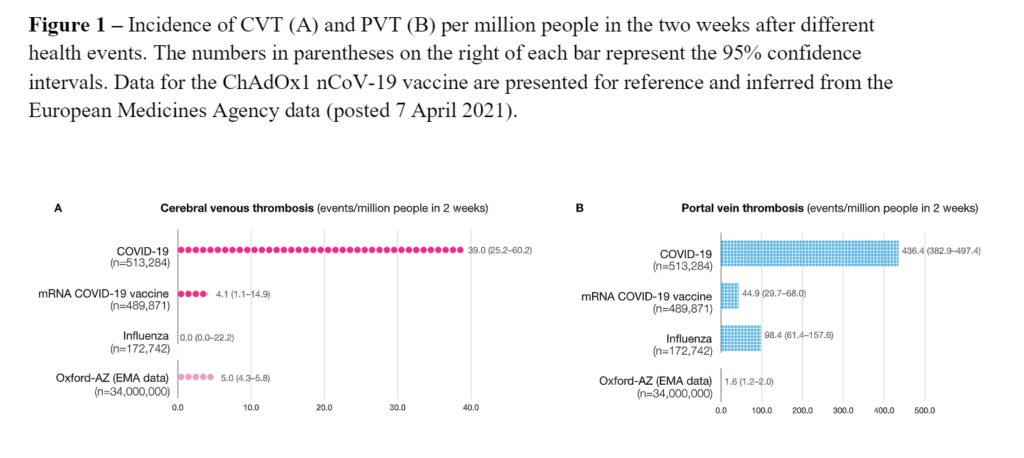Link: https://osf.io/a9jdq/
Graphic:

Abstract:
Using an electronic health records network we estimated the absolute incidence of cerebral venous thrombosis (CVT) in the two weeks following COVID-19 diagnosis(N=513,284), or influenza (N=172,742), or receipt of the BNT162b2 or mRNA-1273 COVID-19 vaccines(N=489,871). The incidence of portal vein thrombosis (PVT) was also assessed in these groups, as well as the baselineCVTincidence over a two-week period. The incidence of CVT after COVID-19 diagnosis was 39.0 per million people (95% CI, 25.2–60.2). This was higher than the CVT incidence after influenza (0.0 per million people, 95% CI 0.0–22.2, adjusted RR=6.73, P=.003) or after receiving BNT162b2 or mRNA-1273 vaccine (4.1 per million people, 95% CI 1.1–14.9, adjusted RR=6.36, P<.001). The relative risks were similar if a broader definition of CVT was used. For PVT, the incidence was 436.4 per million people (382.9-497.4) after COVID-19, 98.4 (61.4-157.6) after influenza, and 44.9 (29.7-68.0) after BNT162b2 or mRNA-1273. The incidence of CVT following COVID-19 was higher than the incidence observed across the entire health records network (0.41 per million people over any 2-week period). Laboratory test results, available in a subset of the COVID-19 patients, provide preliminary evidence suggestive of raised D-dimer, lowered fibrinogen, and an increased rate of thrombocytopenia in the CVT and PVT groups. Mortality was 20% and 18.8% respectively. These data show that the incidence of CVT is significantly increased after COVID-19, and greater than that observed with BNT162b2 and mRNA-1273 COVID-19 vaccines. The risk of CVT following COVID-19 is also higher than the latest estimate from the European Medicines Agency for the incidence associated withChAdOx1 nCoV-19 vaccine (5.0 per million people, 95% CI 4.3–5.8). Although requiring replication and corroboration, the present data highlight the risk of serious thrombotic events in COVID-19, and can help contextualize the risks and benefits of vaccination in this regard.
Author(s): Maxime Taquet, Masud Husain, John R Geddes, Sierra Luciano, Paul J Harrison
Date Accessed: 19 April 2021
Publication Site: OSFHOME